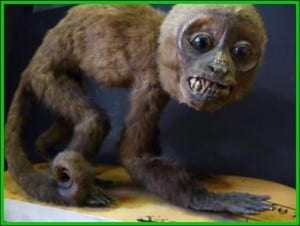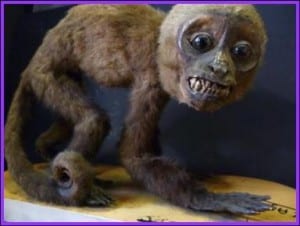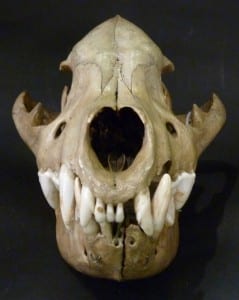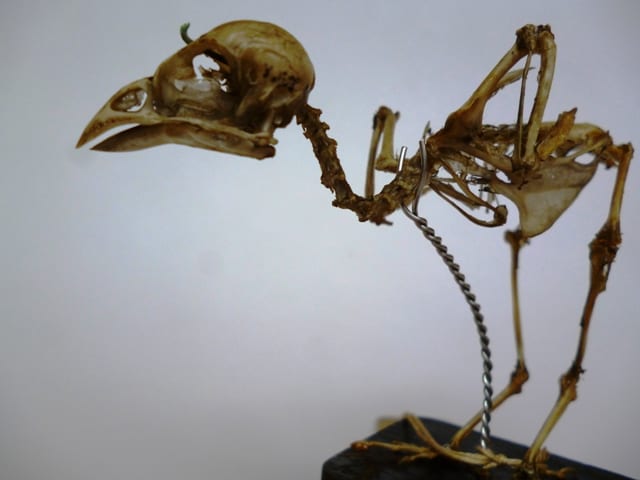Animals and their super senses
By Dean W Veall, on 26 August 2014
Guest blogger Dr. Helen Czerski
Peering up the nose of a hyena is not generally on the “to do” list of most people. As a physicist it’s also not the sort of thing you are trained to do, either. Fortunately for me, this hyena was long-dead – I was only faced with a skull that had just been borrowed from its display case in the Grant Museum of Zoology. And its nose was well-worth ogling.
Specimen of the Week: Week 150
By Pia K Edqvist, on 25 August 2014
 I did not really have a choice selecting the specimen of the week; this as a particular specimen was speaking to me in the corner of one of the display cases, I felt somewhat hypnotised. Firstly because the way it looks; it has an extraordinary appearance consisting of a lattice-like pattern in a somewhat geometric and architectural design, the specimen is very beautiful. Is it actually made of glass? Studying this specimen it has proven to have depth (it lives in the deep sea) but also breadth; its uses are many and its fascinating qualities are still investigated, this animal still raises more questions than provides answers.
I did not really have a choice selecting the specimen of the week; this as a particular specimen was speaking to me in the corner of one of the display cases, I felt somewhat hypnotised. Firstly because the way it looks; it has an extraordinary appearance consisting of a lattice-like pattern in a somewhat geometric and architectural design, the specimen is very beautiful. Is it actually made of glass? Studying this specimen it has proven to have depth (it lives in the deep sea) but also breadth; its uses are many and its fascinating qualities are still investigated, this animal still raises more questions than provides answers.
This week Specimen of the Week is… Read the rest of this entry »
Specimen of the Week 149
By Dean W Veall, on 18 August 2014
 Dean Veall here. Here I am again presenting my choice of the 68,000 specimens here in the collection. My previous choices have included the tiger beetle and the box jellyfish, so what have I gone for this week? Well, here are the teasers, this week I have chosen what I believe to be one of the showiest animals in the UK, was collected close to my Valleys home of Bargoed in Brecon and is a specimen that I came across whilst rummaging through the drawers of the Museum, which means it is not usually on display. This week Specimen of the Week is… Read the rest of this entry »
Dean Veall here. Here I am again presenting my choice of the 68,000 specimens here in the collection. My previous choices have included the tiger beetle and the box jellyfish, so what have I gone for this week? Well, here are the teasers, this week I have chosen what I believe to be one of the showiest animals in the UK, was collected close to my Valleys home of Bargoed in Brecon and is a specimen that I came across whilst rummaging through the drawers of the Museum, which means it is not usually on display. This week Specimen of the Week is… Read the rest of this entry »
The Not So Beautiful Birds
By Mark Carnall, on 13 August 2014
Recently this specimen and a number of other bird skeletons came back from our conservation lab. When I first started at UCL these nine skeletons were in the dreaded “curator’s cabinet” a cabinet of broken and miscellaneous specimens that were presumably the bane of previous curator’s lives. These skeletons were fragmented, partially disarticulated and all the fragments mixed together. I gave these specimens to Gemma Aboe who was undertaking some conservation work for us and she managed to piece together a number of half skeletons from this mixed box. These specimens aren’t the kind of thing you normally encounter in a public natural history museum display as they aren’t ‘perfect’ but I couldn’t resist taking a few extra shots of these whilst documenting them as although they are incomplete and not ‘worthy’ of a spot on display they are still quite hauntingly beautiful.
Specimen of the Week: Week 148
By zcqsrti, on 11 August 2014
 Zombies aren’t real… or are they? In the world of nature, pretty much anything you come up with already exists: What’s that, a lizard that shoots blood out of its eyes? Yup, that’s been done. What about a toad with babies that burst out its back? Nah, you have to be more creative than that!
Zombies aren’t real… or are they? In the world of nature, pretty much anything you come up with already exists: What’s that, a lizard that shoots blood out of its eyes? Yup, that’s been done. What about a toad with babies that burst out its back? Nah, you have to be more creative than that!
But zombies? Practically anything along the subject makes me prance around like a toddler, combine them with one of my other most favourite things in the world – insects – and I’m a giddy puddle.
Boy, this is a treat for you guys! It’s our first non-zoological specimen of the week. That is, if you don’t count the fact that there’s a dirty great big caterpillar stuck to it, and no, this isn’t a case of the mysterious battery-stuffing opossum maniac up to their usual museum antics again with the Pritt-Stick; the two are fused in a macabre display of harmony, mutual love and zombification.
This specimen of the week is…
We’ve Added 600 New Labels, But Can we Label Everything?
By Jack Ashby, on 6 August 2014
The answer to that question is no, we can’t label everything. We’ve just installed 600 new labels in the Museum, as a result of visitor feedback. But have we got the balance right?
There are about 6000 animal specimens on display in the Grant Museum (which, incidentally, is more than is on display at the Natural History Museum), including about 2300 in the Micrarium. The room is only about 250m², and this means our displays are very densely packed. We are hugely keen on specimens at the Grant – providing close access to real objects is one of our biggest selling points. For this reason (and also because we don’t have a lot of storage space), we put as much out on display as is logistically possible.
Drawbacks of dense displays
As much as people tell us they think of the Grant Museum as a room crammed with amazing rare things creating with an atmosphere that promotes exploration, filling every spare gap with objects does have its downsides. Some people think that displays should give each object its own space to breathe, allowing people to concentrate on them, but we’ve made the decision to go in a different direction. Plenty of other museums use this sparse display philosophy – but if you want to be immersed in a real and different celebration of objects, come to the Grant Museum.
The major drawback of jam-packed cabinets is that there isn’t a lot of room for labeling. Read the rest of this entry »
The Petrie Geeks Out (Again)
By Debbie J Challis, on 5 August 2014
Next week the Petrie Museum of Egyptian Archaeology is exhibiting at LonCon3 – the largest science fiction (SF) convention in the world. We’ll be there alongside exhibits on Doctor Who, Iain M Banks, academic posters on SF and English Heritage. But why is a museum of Egyptian Archaeology going to this mahosive SF convention? Read the rest of this entry »
Specimen of the Week: Week 147
By Jack Ashby, on 4 August 2014
 Museums are full of mysteries (particularly when you are as cursed with historically challenging documentation, as many university museums are). For example, why do we have a plum in a jar? Why don’t we have a wolf, one of the world’s most widespread mammals? Who ate our Galapagos tortoise? Why do we only have the heart and rectum of a dwarf cassowary? Why is scary monkey (pictured) so scary?
Museums are full of mysteries (particularly when you are as cursed with historically challenging documentation, as many university museums are). For example, why do we have a plum in a jar? Why don’t we have a wolf, one of the world’s most widespread mammals? Who ate our Galapagos tortoise? Why do we only have the heart and rectum of a dwarf cassowary? Why is scary monkey (pictured) so scary?
Not to mention, why did we put all those moles in that jar?
After ten years of working here, I am confident that there is no greater mystery in the Grant Museum than this one: why would you stick a battery in a dead animal?
This week’s Specimen of the Week is… Read the rest of this entry »
Re-packing UCL´s Magic Lantern Slides
By uclqmbr, on 29 July 2014
As my time working with UCL’s lantern slides draws to a close, I thought I’d reflect on some of the things I’ve discovered over the past few weeks. (To learn what lantern slides are, and why UCL has accumulated thousands of them, click here).
The majority of the slides in the UCL Science and Engineering collection are, unsurprisingly enough, about Engineering. Electrical Engineering to be precise. I must say that, having not had a single Physics lesson in the past six years, the prospect of cataloguing slide after slide of what looked like identical electric circuits was not exactly my cup of academic tea. But I soon learnt that there is a lot more to ElecEng (as it is apparently abbreviated) than alternators, resonators, oscillators and commutators. In particular, I became interested in UCL’s very own Sir John Ambrose Fleming, founder of England’s first University Department of Electrical Technology, inventor of the thermionic valve and Pender Professor at UCL for three decades.
Specimen of the Week: Week 146
By Dean W Veall, on 28 July 2014
Dean Veall here. This week it is I who am bringing you specimen of the week and I have the great pleasure of bringing you specimen 146! Huzzah. But can it really have been seven whole weeks since I last shared a specimen with you? In my role of Learning and Access Officer I have several hats I wear, (these hats pale in comparison to the hats worn by Joe Cain during our Film Nights) so more like caps then. Naturally they are of the flat variety, or as we call them back home Dai Caps, reflecting my heritage, politics and social status as a ‘working class hero’ (who works in the arts and cultural sector!?). When I take off my more showy Dai Cap I wear for our evening events for adults that showcase UCL research I put my more hardier Dai Cap I wear during the day for our Schools learning programme. This week’s specimen of the week is one that I use heavily in our sessions we run for primary schools here in the Museum. It is one that inspires a myriad of questions from the pupils, most frequent being that old favourite “Is it alive?” and a new kid on the block “But why is it moving?”. To find out the answers to these questions and more read on. This week’s specimen of the week is……….
 Close
Close





